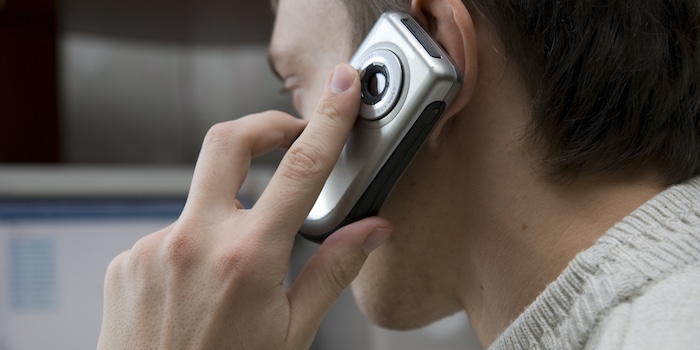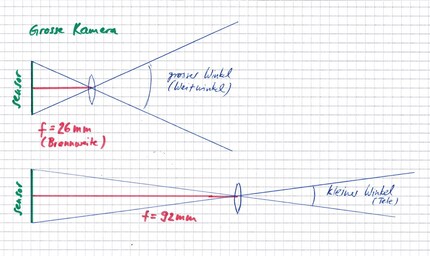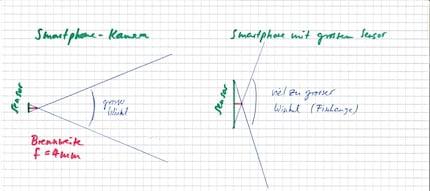
Guide
These cameras can capture images before you’ve even finished clicking
by David Lee

Smartphone manufacturers should build decent sensors into their cameras instead of putting more and more lenses on the back. This is a common demand. However, there are good reasons why this will not happen in the future.
In a recent article, fellow editor Dominik argued that it doesn't really matter how many cameras are on the back of your smartphone. Because the race is decided by the software.
In the comments to this article, user Tony s writes:
What an incredibly stupid trend. From a photographer's point of view... They should put fast lenses (f1.2 /1.4) and larger sensors (lower pixel density and therefore much less image noise) in the smartphones.
Unfortunately, it's not that simple. But I believe this view is widespread. That's why I'd like to go into it in more detail.
As far as fast lenses are concerned, manufacturers have realised this and have made significant improvements in recent years. There are some smartphone cameras with an aperture of f/1.6, the Samsung Galaxy S9 even has f/1.5. However, there is one problem: the aperture of a standard smartphone camera cannot be changed. With a very high aperture, this means that too much light can reach the sensor in sunshine and the photos are overexposed. This is why the Samsung Galaxy S9 is the first smartphone in the world to have an adjustable aperture. I don't know how difficult it is to build an adjustable aperture into such a tiny lens - but it certainly makes the design more complicated and more expensive.
And now to the more interesting point, namely the sensor size. Of course, a larger sensor would make many things better:
It is therefore understandable that photography enthusiasts are demanding larger sensors. Why aren't manufacturers listening to them?
The answer is simple: larger sensors are not physically possible.
The sensor size must be in a sensible ratio to the focal length. This is because both factors, sensor size and focal length, have an effect on the image section.

This means that if we want to use a larger sensor, we have to increase the focal length to create the same image section. And this is exactly where the problem lies. In a smartphone, the focal length is very short, usually four millimetres. The lens and sensor are built in such a way that a certain image section is created at these four millimetres, which we call a wide angle. This means that the image section is rather large. A lot of the surroundings are captured, and you can only take very small pictures of distant objects.
If I now use a larger sensor, the image section becomes even larger. But I don't want that because it tends to be too large anyway.

I would therefore have to extend the focal length to get the same image section again. But that's not possible because the smartphone would have to be thicker. Or the smartphone camera would protrude significantly. Somehow, the distance between the sensor and the lens has to be increased. In any case, the result is a design that nobody wants on a smartphone.
We often read that the iPhone or Galaxy S9 have a focal length of 26 millimetres. This is wrong, these phones have a focal length of 4 millimetres. This 26 mm does not actually refer to the focal length, but rather the image section.
The idea is that the image section would be the same as with a 35 mm camera (= full-frame camera) with a focal length of 26 mm. This size is used to compare the image section of lenses, even though they have different sensor sizes. This value is somewhat misleadingly called "35 mm focal length", which then quickly becomes just "focal length", which is definitely wrong. A phone that actually has a focal length of 26 mm would have to be at least 26 mm thick.
The image section that we perceive as "normal", as natural, is 50 mm in 35 mm format. With a typical smartphone sensor, that would be 7 to 8 mm. You could perhaps just about tolerate that. If you are very tolerant.
If we now place the sensor of a compact camera such as the Sony RX100 in a smartphone, the focal length for this image section is 18.5 mm. The smartphone would have to be around two centimetres thick. With the typical smartphone wide-angle image section, it would still be one centimetre thick. At the very least.

Manufacturers such as Samsung, Nikon and Panasonic have already tried. The "smart camera" Panasonic Lumix DMC CM1 actually has a sensor as large as the Sony RX100. Unsurprisingly, with the protruding lens, the thing is just over two centimetres thick.
You can also think about it the other way round: Sony would certainly make its compact camera just a few millimetres thick if that were physically possible. They don't make things that thick just to annoy you.
The fact that smartphone manufacturers are tinkering intensively with their camera software and have recently been putting more and more lenses on the back also has to do with the physical limits of the hardware. In other words, the companies need to change things where they can be changed.
Many software tricks have something to do with multiple shots in one form or another. Either several lenses take a picture at the same time, or the same lens takes several photos in quick succession. These almost identical images are then combined into a "master image". This allows weaknesses in the hardware to be masked.
However, I also believe that more and more cameras are not much use. The best-known tricks of multiple images work with the "fast from one camera" method. For example, the elimination of image noise or excessively harsh light. With several cameras, several image sections can be realised. The result is something similar to a zoom capability. However, this zoom is not primarily achieved by extending the focal length - because that is not possible - but mainly by reducing the size of the sensor.
Cover image: Adobe Stock/Dakota. His mobile would be thick enough, but who wants one of those these days?
My interest in IT and writing landed me in tech journalism early on (2000). I want to know how we can use technology without being used. Outside of the office, I’m a keen musician who makes up for lacking talent with excessive enthusiasm.
Practical solutions for everyday problems with technology, household hacks and much more.
Show all